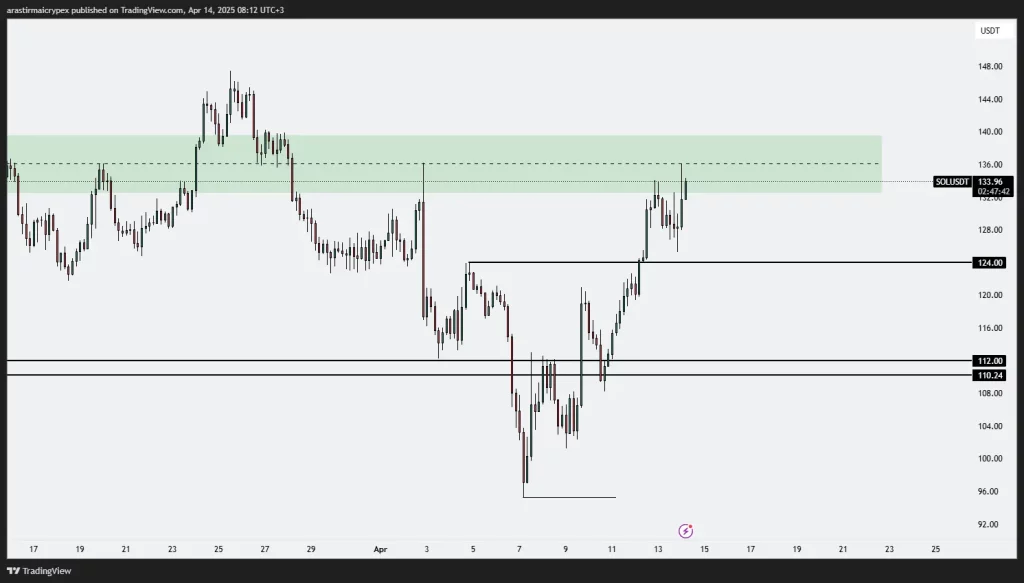Trump’s Tax Break Revives Market – 90% Drop in MANTRA!
Trump’s Tax Exemption Revived the Market
Bitcoin aims to end the downtrend of the last three months by rising 1.5% to $84,900. The US’s exemption of products such as smartphones, chips and computers, despite the high taxes imposed during the Trump era, was effective in this recovery. This move is being interpreted as a step back in the trade war.
Despite Trump’s 125% import tax on China, the exemptions brought to smart devices and electronic products were perceived as a sign of softening in the market. According to The Kobeissi Letter, these exemptions are a step towards protecting the US’s annual phone imports exceeding $60 billion. These developments support Bitcoin’s efforts to break the downtrend line, while the up to 6% increases seen in altcoins such as ETH, XRP and ADA also show that risk appetite is reviving in the markets.
90% Drop in MANTRA!
Mantra’s native token OM lost more than 90% of its value in 24 hours, almost eliminating its $6 billion market value. The token price fell from $6.3 on April 13 to below $0.50. Some investors interpreted this decline as the biggest crash since the LUNA and FTX crises. While the reason for the decline is not yet clear, the project team announced that it has started investigating.
Mantra co-founder JP Mullin stated that the project is still active and that the team’s tokens are in their own wallets. The decline came after the company signed a $1 billion tokenization agreement with DAMAC in January 2025 and received a license from Dubai in February. Despite these developments, the sharp price movement left serious questions in the minds of investors.
SEC Signals Temporary Regulation for Crypto Platforms
The US Securities and Exchange Commission (SEC) discussed a short-term regulatory framework for platforms at the latest crypto asset roundtable in Washington. Interim Chairman Mark Uyeda stated that a “time-limited and conditional” exemption mechanism could be on the agenda to support innovation in the sector.
Uyeda said that the SEC is working on permanent regulations, but that temporary solutions could be considered to ensure that crypto companies continue to innovate in the US in the meantime. Hester Peirce, who heads the crypto task force, questioned how a suitable framework could be created for platforms that want to offer both securities and non-securities services under the same roof. On the other hand, the only Democratic commissioner, Caroline Crenshaw, warned that the combination of multiple functions in the same structure by platforms poses conflicts of interest and risks for investors.
Emission Limits Coming to Crypto Mining in the US
The “Clean Cloud Act of 2025” bill submitted to the US Senate imposes regional emission limits on crypto mining facilities and artificial intelligence data centers. According to the bill, facilities will have to operate on 100% renewable energy by 2035, or face heavy fines. Emission limits will be reduced by 11% each year, and fines for facilities that exceed the limit will be calculated according to the amount of the exceedance.
The bill also requires facilities consuming more than 100 kW to submit annual electricity usage reports. The EPA will calculate carbon intensity with this data and determine fines accordingly. The resulting fines will be distributed as grants to local municipalities and directed towards clean energy investments. While Republican opposition is expected, President Trump wants the US to be the largest Bitcoin mining power. The bill could be at the center of political debate because it runs counter to that goal.
Janover’s Shares Soar 1,100% After Solana Move
Commercial real estate finance firm Janover has purchased more than 83,000 SOL (about $9.6 million) as part of its digital asset treasury strategy and plans to stake these assets and generate on-chain income by running validators. This strategy was launched after the company completed a $42 million funding round recently, causing a 1,100% jump in its share price.
Janover’s CEO stated that they aim to make the company the most transparent vehicle for accessing crypto in the public markets. They position Solana not only as an investment vehicle, but also as a “compound growth engine” for capital efficiency thanks to its high volatility and staking features. For now, Janover, who is only focusing on SOL, may add other crypto assets he has high confidence in to his treasury in the future.
April 16 is the Critical Date in the Ripple Case
The years-long case between Ripple and the U.S. Securities and Exchange Commission (SEC) seems to be nearing an end. Both parties filed a joint application to stop the appeal process. This move has led to the expectation that the case could conclude with a settlement by April 16. Legal expert Fred Rispoli stated that he expects a 90% chance of a settlement or an appeal withdrawal announcement on this date.
The case began with the SEC defining XRP as an unregistered security, and in July 2023, the court made a partial decision in favor of Ripple. A possible agreement could clarify whether crypto assets are securities or currencies. This development could have major implications for regulatory clarity and institutional interest in the crypto market, especially under new SEC Chairman Paul Atkins.
Saylor’s New Bitcoin Buy Signal
Bitcoin bull Michael Saylor has signaled that his firm Strategy has resumed buying BTC after a week-long pause. The firm purchased 80,715 BTC in the first quarter of 2025, but reported an unrealized loss of approximately $6 billion at the end of the quarter. During this period, the price of Bitcoin fell 12%, showing its worst quarterly performance since 2018. Strategy’s total BTC holdings reached 528,185, with an addition of 22,048 BTC in the latest purchase.
The firm, which has invested approximately $35 billion in total, has an average cost of $67,485 per Bitcoin. This position accounts for approximately 3% of the BTC supply and is currently valued at around $44 billion. Saylor’s BTC follow-up post on X is often interpreted as a precursor to a new purchase announcement.
McDonald’s Shareholders’ Bitcoin Proposal Rejected, SEC Approved
McDonald’s has decided not to bring up the Bitcoin purchase proposal from its shareholders at its upcoming general meeting. The National Public Policy Center, a conservative think tank, sent a proposal to McDonald’s management asking them to consider the Bitcoin purchase. However, McDonald’s refused to put this proposal on their agenda and applied to the SEC, stating that no sanctions should be imposed on the subject.
The SEC confirmed that McDonald’s had the right to remove this proposal from the general meeting agenda. In its response dated March 28, the SEC stated that the company’s rejection of such a proposal was within the scope of the company’s “ordinary business operations” and that they would not take any regulatory action in this case. The decision means McDonald’s will not consider a shareholder proposal to buy Bitcoin.
Bank of England Warns About Stablecoins
The Bank of England (BoE) and the Financial Conduct Authority (FCA) are creating regulatory frameworks against the increasing use of stablecoins. According to the BoE’s April 2025 report, mismanagement and insufficient collateralization of these assets could threaten financial stability. Stablecoins can create liquidity problems and lead to sudden selling pressures, especially during stressful market periods.
The FPC noted that stablecoins, especially those pegged to foreign currencies, could increase the risk of currency substitution in the UK economy. In addition, swapping these assets outside of central bank money could increase systemic risks and undermine the central bank’s ability to balance the market. The BoE has stressed that early regulatory steps are crucial for stablecoins to be used safely in payment systems.
A School in the UK Will Accept Bitcoin
The private Lomond School in Scotland has announced that it will accept payments in Bitcoin after parents requested it. The school, which will be the first to implement this method in the UK, will phase in payments and convert BTC received into British pounds. It also said it will fully comply with UK financial regulations.
The school will also consider creating a BTC reserve if Bitcoin becomes more widely adopted in the UK and around the world. The move is similar to a decree issued by US President Trump last month that authorized the government to investigate ways to hold and purchase Bitcoin. The tendency of states and companies to evaluate BTC as a reserve asset is increasing.
——————————————————————————————
BITCOIN (BTC)
BTC is trading at $ 84,650 with a 1.07% increase in value as of the morning hours. It has risen with the reaction it received from the 76,600 support and is currently trading at 84,795. The 83,858 level is traded as short-term support. On the upper side, the 88,765 level appears as a strong resistance. This resistance level should be watched carefully as it is also the area where the price has fallen sharply before. In a downward correction, the 83,858 and 77,000 range can be watched for purchase. In the upward break, new peaks can be discussed.
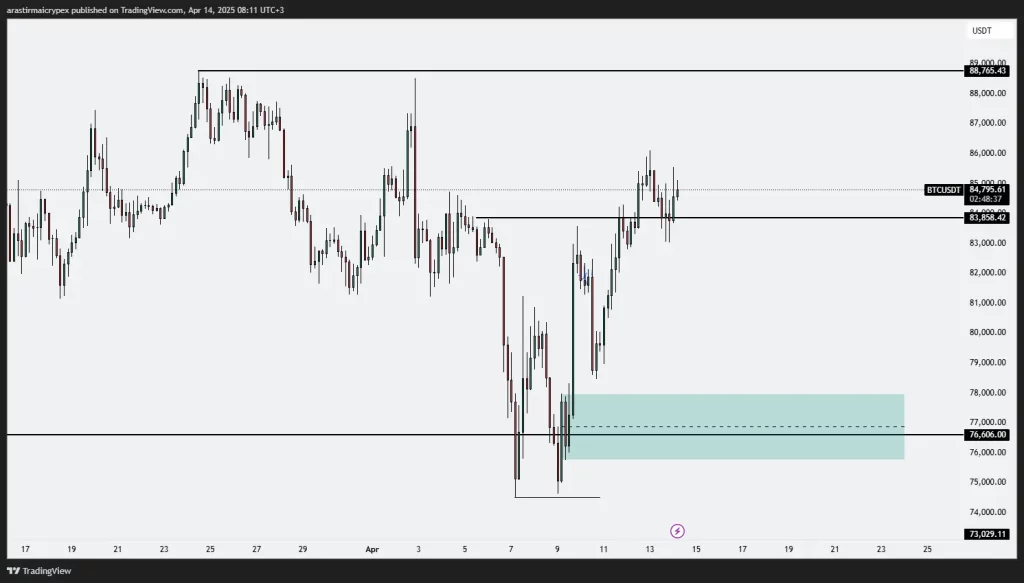
ETHEREUM (ETH)
ETH is priced at $ 1636 as of the morning hours with a 2.44% gain in value. With the rise it started from below 1,550, it reached the blue supply zone at 1,680. This zone has worked as both support and resistance in the past, and as of now, the price has been rejected from this zone. If the price cannot rise above this level, the 1,600 and 1,550 supports may come to the fore again. On the other hand, closing above 1.768 will confirm the medium-term uptrend.
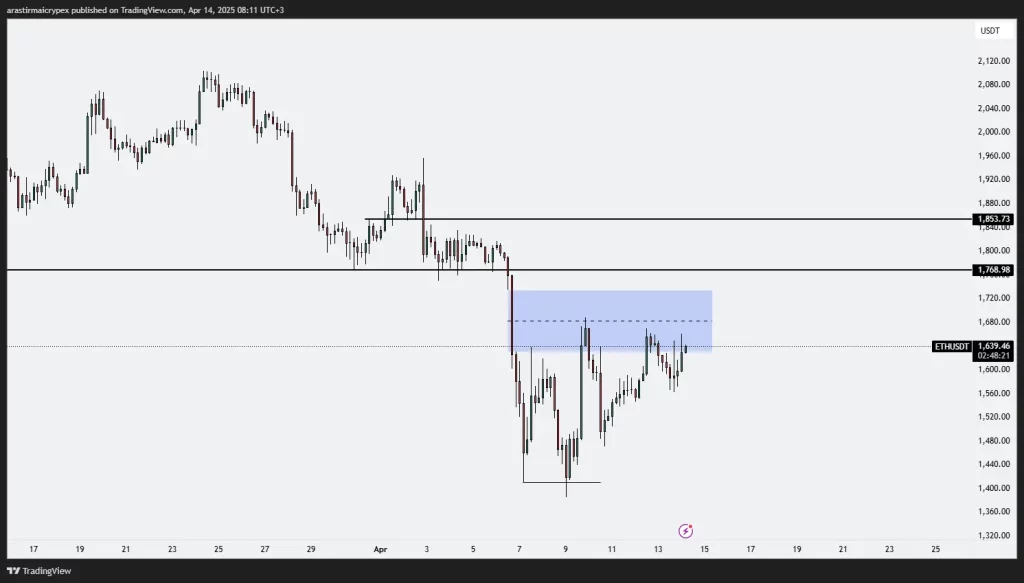
RIPPLE (XRP)
XRP is trading at $ 2.14 as of the morning hours with a 1.23% gain in value. After the last decline, it recovered from the 1.6166 level and rose to the 2.1705 level, which corresponds to the 61.8% Fibonacci retracement. This region is a technically important resistance area and the price is seen to be consolidating at this level. If this resistance is not overcome, the 2.11 and 1.89 levels can be tested again. However, in case of a breakout, levels of 2.35 and above can be targeted. Therefore, the reaction of the price in the 2.17 region should be monitored carefully.
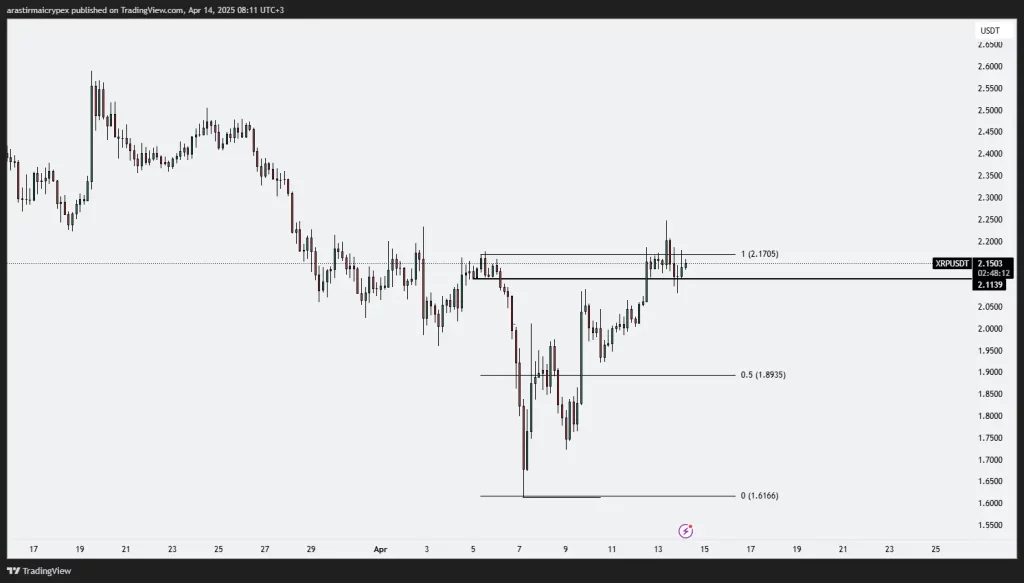
AVALANCHE (AVAX)
AVAX is traded at $ 20.02 as of the morning hours with a 2.81% gain in value. It continued its uptrend that started at 15.27 and reached 20.20. The 19.95 level on the chart works as a short-term resistance and the price is testing this area. The 21.88 level is followed as a strong horizontal resistance. Below, the 17.74 and 16.47 supports stand out as important pullback areas. In particular, a close below 16.47 may indicate a weakening trend. Closes above 21.88 should be followed for the continuation of the rise.
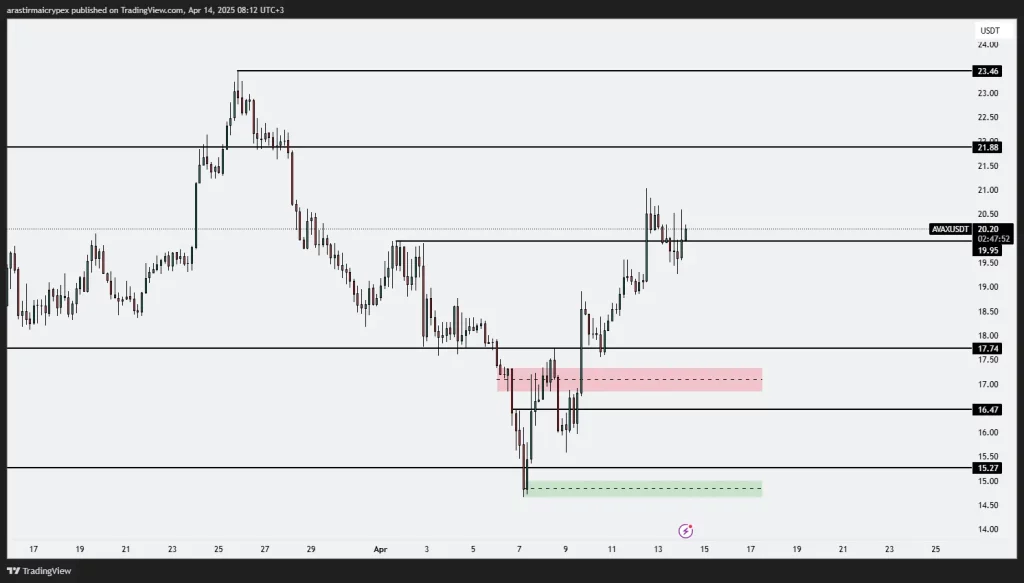
SOLANA (SOL)
SOL is trading at $ 134 levels with a 4.56% gain as of the morning hours. After breaking the horizontal support at 124 with the last rise movement, it quickly reacted upwards and reached 133.96. The green zone marked on the chart is a supply zone covering the range of 135 – 138 and stands out as the region where selling pressure has increased in the past. For this reason, this area should be monitored as a resistance zone where the probability of the price being rejected is high. If there is a break above this area, previous highs can be retargeted. However, a selling pressure from this area could pull the price back to 124.
